QuestionHi. I have a 4 yr old Paint gelding named Naters that I purchased about 2 mos ago. He had been in front shoes since he was around 2. He had never had any hoof problems and the vet who did the pre-purchase exam said his hooves were really good. This is my first horse to own, but I rode a lot as a child into my teens and early twenties. About a month ago, he threw his right front shoe. He had just had them done about 2 weeks previously. Didn't think anything of it. Farrier came out and replaced both shoes and trimmed the back. Had a lot of people telling me I should let him go barefoot. I live in North Texas and ride in pretty sandy soil, some rocks and gravel. Trail ride and arena work for Western Pleasure, but I am not competing. Last week, he threw the left front shoe. He has a lot of nail holes and he tends to drag his front toes and he sometimes will overreach. Farrier came out replaced the shoe. He lost it within 5 hours. At this point, I talked to the stable owner who is a strong supporter of barefoot. I decided to just do it. Got the farrier out. Pulled the other shoe and got a really nice trim on all fours, but the farrier told me he has a very weak hoof wall and I am not going to be happy with the outcome of him being barefoot. Said he also has starting signs of bacteria in the hoof wall. He said he was flaring on the back hooves from the weak wall pulling apart. I've never had to deal with any of this and am skeptical. His hooves don't look bad to me, but his overall hoof is bone colored with black vertical pinstripes and the hoof wall and white line is very black. I don't know if this is normal for him or not. Farrier wants me to put merthiolate on the white line and hoof wall, then he thinks he's pulling the shoes off and wants to put a 1 1/2 shoe on him instead of the 2. I really want to leave him barefoot. He's riding better than he had been in the last few weeks. Trots at ease and seems to dragging his toes less, which has drastically reduced stumbling and no overreach at all. I have put him on Farrier's Formula and started using LifeData Hoof Disinfectant, only problem is that I have a horrible time getting him to lift his front hooves for me. He did great the first few weeks after I got him and would lift on demand for the previous owner and also the vet and farrier. He won't lift for my trainer or me. After about 10 mins of persistence, he will finally lift and stand perfectly. It's been frustrating, because I feel I have to get his hooves clean and medicated each day. I honestly think he is just trying me and I have to persist to he does what I want, but it wears me out to spend 10-15 getting one front hoof lifted and another 10-15 for the other front. He lifts the back on command everytime. Just not the fronts. So...what should I do? Have the farrier go ahead and put the shoes back on? Do you think I have a hoof problem with bacteria? Sorry this is so long. Just really concerned about Naters and want to do what is best for him. He is my life and a big part of my family. I only want to do the right thing, but am not certain what is right in this case. Your help will be greatly appreciated.
AnswerHello Pennie,
thank you so much for the question.
I could respond very quickly to this - leave the shoes off and see what happens and get a farrier who is experienced with trimming barefoot riding horses! :-)
Ok..here is the long version of my answer :-)
You have already told me a lot of things that would be indications for me that the horse should be left barefoot, at least for the time being or until he shows you signs of not being able to go barefoot. That said, there may very well be a transition period when you cannot do all the riding you want to and on any type of ground but your horse will tell you. Also, if you want to invest in a pair of hoof-boots at one time to be able to ride him on more difficult ground on trails, that is a great option!
Re: dealing with a potentially weak hoof wall , leaving shoes of and giving hoof supplements, just as you are doing is great. I would have recommended just the same. You are in a great situation since other horse owners around you are advocates for barefoot, so having their support is fantastic (often farriers, barn managers and trainers are all about shoes and wanting to go barefoot is an uphill battle).
As to putting shoes on BECAUSE of a weak hoof wall is something I have never understood since, as you have already seen, weak hoof wall means that the nails won't hold the shoes which means that they get thrown or ripped off and then re-attached with even more nails which rip off even more hoof wall when the shoe gets throw which leaves the hoof wall even more compromized and gives more entry to bacteria...etcetc...you can see where I am going with this. Glue-on shoes are also not an option in my mind since they do leave the shoe on very well but at one point you have to get them back off and that means grinding and rasping...also the glue that holds them on is not the best for a health hoof wall either...
From my experience, in a situation where shoes not longer stay on the very best thing to do is transition to barefoot and see what happens. Not to say anything bad about your farrier, since of course I am not there and don't have the full picture and your farrier is probably doing an excellent job for shoeing, but from what you say that one of the reasons why s/he recommended to keep shoes on is because the hooves are flaring in the back tells me that you are getting a farrier trim (the way the hoof is prepared to put shoes back on) and not a trim that is appropriate for going barefoot. Unfortunately, many people think that a trim without shoes is just trivial and not very difficult - NOT!!! The correct trim and balance for ANY horse, shoes or not is key. The difference is that with shoed horses, the farrier usually has to manage growth of the hoof since wear is minimized due to the shoes while with a barefoot horse, you manage both growht and wear which requires a totally different look at the hoof and the way you address your montly trims to balance and shape the hoof. You can see great examples of a well trimmed hoof on barefoot horses on may barefoot websites and if you google for barefoot horse, you can get a lot of nice sites...some are more dogmatic than others about techniques and approaches and some are totally against shoes and use arguments in that direction that I do not find are sound. Anyway...have a look and if you would like advice for sites or pics of well trimmed bare hooves versus farrier trims, I can get you some of these as well.
As to the color of his hooves with the stripes, he is a paint horse and multi-colored hooves are a part of being a paint, so unless these discolorations are reddish and painful, they are normal and may horses with white hooves have black or brown streaks in them. Not to worry!
And regarding him not wanting to pick his hooves up...yes, he is probably messing with you...also, please keep in mind that you are still a new person for him. It is a very scary thing for horses to give away a front leg to someone they don't know very well. As a prey animal, you can't run very well if one of your legs is compromized. I think the reason why he is ok with the hind may be that you can get out of scary situations faster by kicking off something on your hind than your front, don't know...so one way you could address this is to do some round pen training with him, if you are experienced with round pen work and ad liberty training, since this can work wonders for horses developing trust and confidence in you and then hoof lifting should be easier. Also when you work with him, don't try to take the leg from him but keep asking and asking until you get the slighest shift of weight off the leg you want to lift and praise him. Every time he gives you a "try" and he gets rewarded, he will give you more and more and once he offers the hoof off the ground, leave it and praise him. DOn't try to hold up the foot once you have it but put it right back done and go on with grooming etc. and then try at a later time. One way to ask him for the foot is to lean into his shoulder and just gently ask him off-balance initially -be careful with this, though, in case he over-reacts and pushes YOU off balance. Have someone help you with this and also be very careful around his hinds, even if he gives them to you...he may not trust you at this point and all it takes is a situation he is worried about and he will take that hind leg away faster than you can react..so please be very careful until you two know each other a bit better (may also explain why he is ok with previous owner and others he knows better!).
So, I would keep the shoes OFF, get a farrier who does riding horses that are barefoot - as I said I would be more than happy to describe to you the differences between a farrier trim and a barefoot trim and expecially how this applies to flares and possible white line disease - this is what your farrier is implying when saying that bacteria have gotten between the hoof wall and the white line. In may experience, once a hoof has the appropriate balance and the nail holes are grown out, what may have looked like compromized horn and white line disease goes away completely. Also with barefoot horses, the hoof wall strengthenes quite quickly, even before a new hoof is grown out. Your horse is the best judge of whether he is ok without shoes or not. In my mind, horses should be kept barefoot unless the work we use them for exceeds what their hooves can handle and or they are used in disiplines that require work they are not naturally built for (such as fast work on soft surfaces that you need extra traction devices for). It sounds like he is already telling you he is ok without shoes since he is going better. Do give him some time to adjust, consider investing in well fitted hoof boots if needed and enjoy him. Also, please have him trimmed regularly - barefoot horses need at least as much hoof care than shod horses, so I recommend 4-5 week intervals for most horses.
Please let me know whether this anwered your questions. I can get you links to sites that I think are great resources for keeping a horse barefoot and can also get you pics to show you the difference between trims for barefoot versus shoes.
whew...that was a long rambling answer (sorry!)...there are so many things we could discuss...I got carried away :-) Take care!
Christine

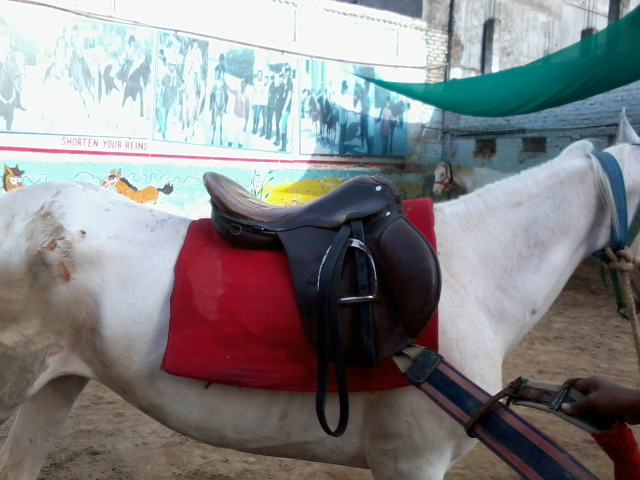 saddle laid correctly
Question
saddle laid
hello Lyn, is this saddle l
saddle laid correctly
Question
saddle laid
hello Lyn, is this saddle l
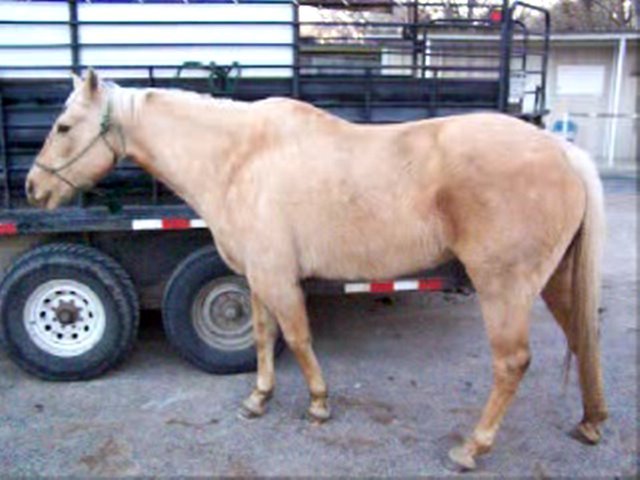 New Horse Owner
Question
Our Beautiful New Mare
Hello Judi,
Yesterday,
New Horse Owner
Question
Our Beautiful New Mare
Hello Judi,
Yesterday,
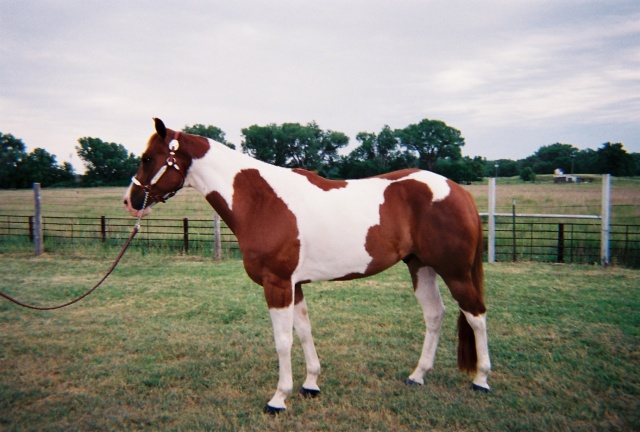 horse height
QuestionQUESTION: hi i have a three year 5 month old fi
horse height
QuestionQUESTION: hi i have a three year 5 month old fi
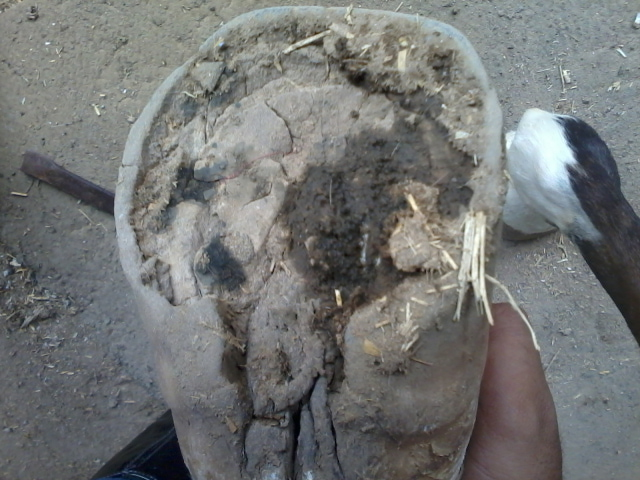 thrush on hoof
Question
thrush
hello. hope you can answer this
thrush on hoof
Question
thrush
hello. hope you can answer this
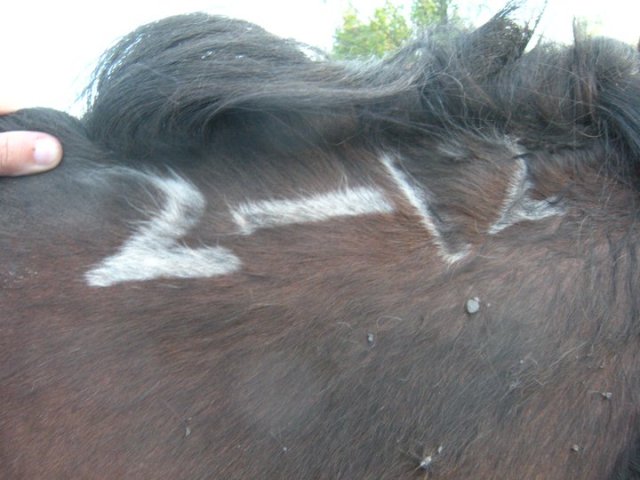 13(?) year old Standardbred mare
Question
Brand
A friend of mine just pulled a mare from
13(?) year old Standardbred mare
Question
Brand
A friend of mine just pulled a mare from